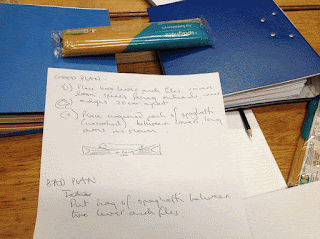Dissecting, analysing, presenting...
Wonderful to devise and lead this session with Andrew and have Celia and Les on the team - learnt so much - had to set aside my anxiety about failure, students being bored or lost - and leave space for things to float a bit, for different things to happen. Fascinating to see the different styles of the groups emerge - the serious, the whimsical, the analytical, the jokers. And loved watching Celia, Les and Andrew dive in to the different conversations and poke / provoke / cheer / cajole - brilliant.
We gave them scraps of clothing and measuring tools and asked them to look and think and make up a 3-minute story to present to their peers - who scored them on clarity, originality and story telling. The lessons from previous sessions seemed to have touched them somehow - more exploratory observation including touch, more confident use of pens and pencils, using their sketcbooks and working at scale.
Our outline lesson plan below and some images here too -
learning outcomes -
- analysing / dissecting an object - different dimensions of observation - material / physical, structural / how it fits into a system and speculative- what it says about behaviour / habitat etc.
- role of measuring tools on the things you notice
- summarising results for others in lively and interesting way
structure for the session-
split into 6 tables,
each table has...
a fragment of a garment - hidden in a bag so they can't see it before they start
suggested fragments..
- brim or bobble from a hat
- finger or thumb from a glove -
- button or zip from a shirt
- pocket, leg or or zip from a pair of trousers
- heel or toes from a pair of socks
- lace or insole from a pair of trainers
also has a measuring device
- vernier calipers (precise thicknesses)
- scales (weight)
- protractor (angles)
- tape measure (lengths)
- small metal ruler (small lengths)
- dulux paint colour chart / chips (colour)
and paper, pencils and pens
Stage 1 - gather - 30 minutes
gather information about the object using measuring devices, drawings, phone camera etc - each person in the group making notes on the paper on the table ( or in their own sketchbooks?), phone camera etc.
3 dimensions
- physical attributes of the fragment itself
- what it might be part of - connections, scale etc.
- what the fragment says about where or how it was used - style, wear (dirt etc.)
Stage 2 - summarise - 30 minutes
put together and rehearse a 5-slide 'pecha kucha' for presentation using the screens (without revealing what it is).
Stage 3 - present - 10 minute getting stuff on line plus 30 minutes / 5 minutes per group
Present to the group






Comments
Post a Comment